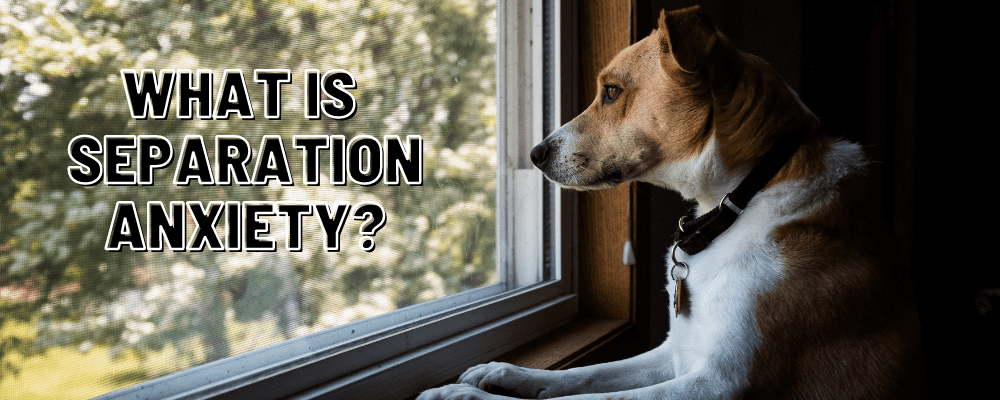What is Separation Anxiety?
Have you ever worried about something to the point where you made yourself physically sick? That is how a dog with separation anxiety feels. Separation anxiety is characterized by a physiologic panic attack, outside of the dog’s control, during a real or perceived absence from a person or animal.
It is caused by a hyperattachment to an individual or another pet. Sometimes dogs panic when a certain person leaves, and sometime it happens only when they are completely alone. Separation anxiety is not a sign of disobedience or dominance. Plain and simple, your dog does not feel safe without you.
How common is Separation Anxiety?
About 20% of dogs in the United States are affected by this disorder. In other words, separation anxiety is very common. There are lots of people standing in your shoes.
Why does my dog have Separation Anxiety? Did I cause it?
Dogs may develop separation anxiety because of a change in the owner’s schedule, after being boarded at a kennel, because of a traumatic event (e.g., lightening strike, smoke alarm test, break-in) or after being brought into a new home.
Dogs with separation anxiety often have other disorders as well, such as generalized anxiety and storm phobia. In other words, dogs with separation anxiety are usually pretty anxious in other ways as well. You did not cause your dog’s behavior. She is not showing dominance to you, and your leadership skills are irrelevant to the development of this disorder.
Most likely, she came to you with separation anxiety, a predisposition toward separation anxiety or the baggage that would cause her to develop it later. Although you did not cause your dog to have separation anxiety, you can help her overcome it.
What does Separation Anxiety look like?
Dogs with separation anxiety may be destructive, especially at points of exit, such as doorways or windows, or they may chew and destroy the owner’s personal articles, such as furniture, clothing or bedding.
Other dogs may bark incessantly or urinate and defecate in the house. Some dogs will become aggressive and try to block the owner as he/she tries to leave the house. Dogs with separation anxiety often look sad or depressed before the owner leaves the house. They frequently follow the owner around even when he/she is not leaving. Some owners cannot even go to the bathroom without a dog at their feet.
What are the treatments for Separation Anxiety?
Because this is not a training problem but is, instead, a physiologic reaction to a stimulus, obedience training is not generally successful as a treatment. The treatment of separation anxiety includes teaching the dog to relax when you leave the house, pairing your departure and the cues that signal it with pleasurable experiences, adding structure to her interactions with you, and elimination of all punishment and independence training.
Often, antianxiety medications are prescribed to help avoid the panic attack as the owner works through the treatment plan. Medication may be temporary (4-6 months) or long term.
A product called Adaptil can be used to help manage separation–related behavioral problems. Adaptil is a product developed to “speak” in the language of canine-appeasing pheromones. By constantly diffusing these pheromones, Adaptil can help reduce the undesirable behavior exhibited by dogs suffering from separation-related problems and hyper-attachment. An Adaptil diffuser can be placed in the room that your dog will be spending the most time when you’re gone. The diffuser should be switched on continuously until the dog’s condition is stable and remains stable for 4 weeks.
I feel like a prisoner in my own home. Is there something that I can do right now to help my dog?
Your veterinarian may prescribe a short-term medication for your dog so that the behavior does not continue to progress. In addition to medications, there are some simple things that you can do to help your dog relax while you are away from home:
Minimize the difference between when you are staying home and departing by ignoring your dog for 5 minutes before leaving and until she calms down when you get home.
Hide all the triggers (e.g., purse, wallet, keys, phone) for your departure that you can by putting then out of your dog’s sight before you leave the house.
Do not confine your dog in a crate unless your dog loves the crate and is comfortable in it.
Leave your dog with an irresistible food item like a food-stuffed Kong toy every time you depart.
Do not punish your dog for her behavior. She is in a state of panic, and any yelling or physical punishment will increase her anxiety and make her afraid of you. She is panicked, not disobedient. Just take a deep breath, clean up the mess and go on with your day.
Will my dog ever be cured?
Cured? Probably not. Your dog’s behavior can be very well managed so that you have a life, your dog has a good quality of life and your home is intact. It will most likely take 1-2 months to get your dog’s behavior under control, but there are things that your veterinarian can do immediately to give you and your dog some quick relief so that you can leave the house without worry while the long-term treatments are implemented.
